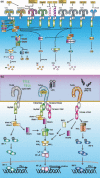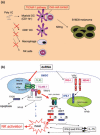Pattern recognition receptors of innate immunity and their application to tumor immunotherapy
- PMID: 20059475
- PMCID: PMC11158504
- DOI: 10.1111/j.1349-7006.2009.01442.x
Pattern recognition receptors of innate immunity and their application to tumor immunotherapy
Abstract
Dendritic cells (DC) begin maturation in response to complex stimuli consisting of antigens and pattern molecules (PAMP) for the activation of the immune system. Immune adjuvant usually contains PAMP. Infection represents one event that is capable of inducing such a complex set of stimuli. Recently, DC were subdivided into a number of subsets with distinct cell-surface markers, with each subset displaying unique differential maturation in response to pattern molecules to induce various types of effector cells. In the present study, we review how pattern recognition molecules and adaptors in each DC subset drive immune effector cells and their effect in the stimulated DC. Although tumor cells harbor tumor-associated antigens, they usually lack PAMP. Hence, we outline the properties of exogenously-added PAMP in the modulation of raising tumor immunity. In addition, we describe the mechanism by which DC-dependent natural killer activation is triggered for the induction of antitumor immunity.
Figures




Similar articles
-
Innate immunity and vaccine.Vaccine. 2010 Nov 23;28(50):8041-2. doi: 10.1016/j.vaccine.2010.09.023. Epub 2010 Sep 17. Vaccine. 2010. PMID: 20849873
-
Toll-Like Receptors in Natural Killer Cells and Their Application for Immunotherapy.J Immunol Res. 2020 Jan 4;2020:2045860. doi: 10.1155/2020/2045860. eCollection 2020. J Immunol Res. 2020. PMID: 32377528 Free PMC article. Review.
-
Bidirectional interactions of NK cells and dendritic cells in immunotherapy: current and future perspective.Immunotherapy. 2015;7(3):301-8. doi: 10.2217/imt.14.122. Immunotherapy. 2015. PMID: 25804481 Review.
-
Two receptor theory in innate immune activation: studies on the receptors for bacillus Culmet Guillen-cell wall skeleton.Arch Immunol Ther Exp (Warsz). 2001;49 Suppl 1:S13-21. Arch Immunol Ther Exp (Warsz). 2001. PMID: 11603865 Review.
-
Fast dendritic cells stimulated with alternative maturation mixtures induce polyfunctional and long-lasting activation of innate and adaptive effector cells with tumor-killing capabilities.J Immunol. 2013 Apr 1;190(7):3328-37. doi: 10.4049/jimmunol.1202024. Epub 2013 Feb 27. J Immunol. 2013. PMID: 23447683
Cited by
-
The peptide sequence of diacyl lipopeptides determines dendritic cell TLR2-mediated NK activation.PLoS One. 2010 Sep 2;5(9):e12550. doi: 10.1371/journal.pone.0012550. PLoS One. 2010. PMID: 20824059 Free PMC article.
-
Development of a novel TLR8 agonist for cancer immunotherapy.Mol Biomed. 2020 Sep 10;1(1):6. doi: 10.1186/s43556-020-00007-y. Mol Biomed. 2020. PMID: 35006413 Free PMC article.
-
Correlation of Asp299Gly and Thr399Ile polymorphisms in toll-like receptor 4 gene with digestive cancer risk: A meta-analysis.Biomed Rep. 2013 Mar;1(2):294-302. doi: 10.3892/br.2012.32. Epub 2012 Oct 29. Biomed Rep. 2013. PMID: 24648938 Free PMC article.
-
TRAIL/DR5 plays a critical role in NK cell-mediated negative regulation of dendritic cell cross-priming of T cells.J Immunol. 2011 Sep 15;187(6):3087-95. doi: 10.4049/jimmunol.1003879. Epub 2011 Aug 10. J Immunol. 2011. PMID: 21832159 Free PMC article.
-
Investigating the molecular mechanism of vitexin targeting CDK1 to inhibit colon cancer cell proliferation via GEO chip data mining, computer simulation, and biological activity verification.Naunyn Schmiedebergs Arch Pharmacol. 2025 Feb;398(2):1637-1652. doi: 10.1007/s00210-024-03341-y. Epub 2024 Aug 15. Naunyn Schmiedebergs Arch Pharmacol. 2025. PMID: 39145810
References
-
- Janeway CA Jr. Approaching the asymptote? Evolution and revolution in immunology Cold Spring Harb Symp Quant Biol 1989; 54: 1–13. - PubMed
-
- Akira S. Toll‐like receptor signaling. J Biol Chem 2003; 278: 38105–8. - PubMed
-
- Yoneyama M, Onomoto K, Fujita T. Cytoplasmic recognition of RNA. Adv Drug Deliv Rev 2008; 60: 841–6. - PubMed
Publication types
MeSH terms
Substances
LinkOut - more resources
Full Text Sources

